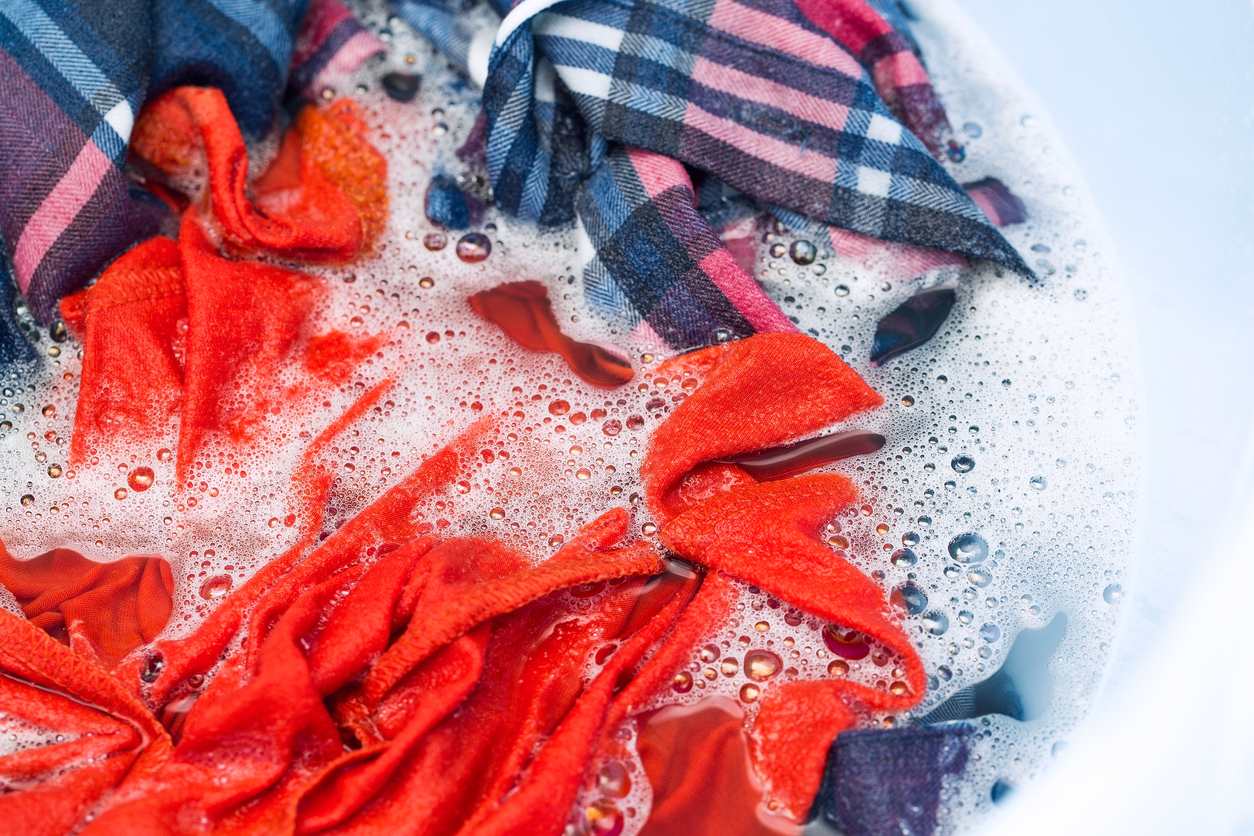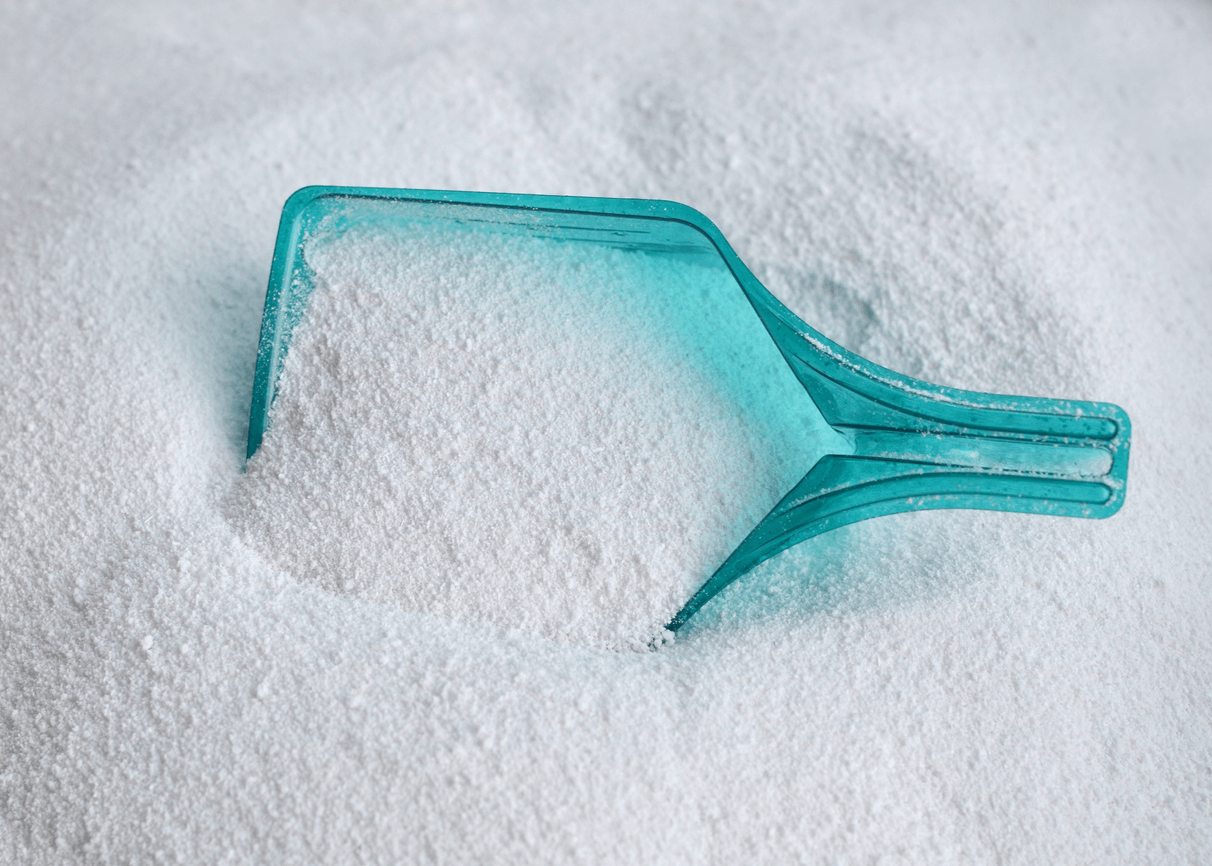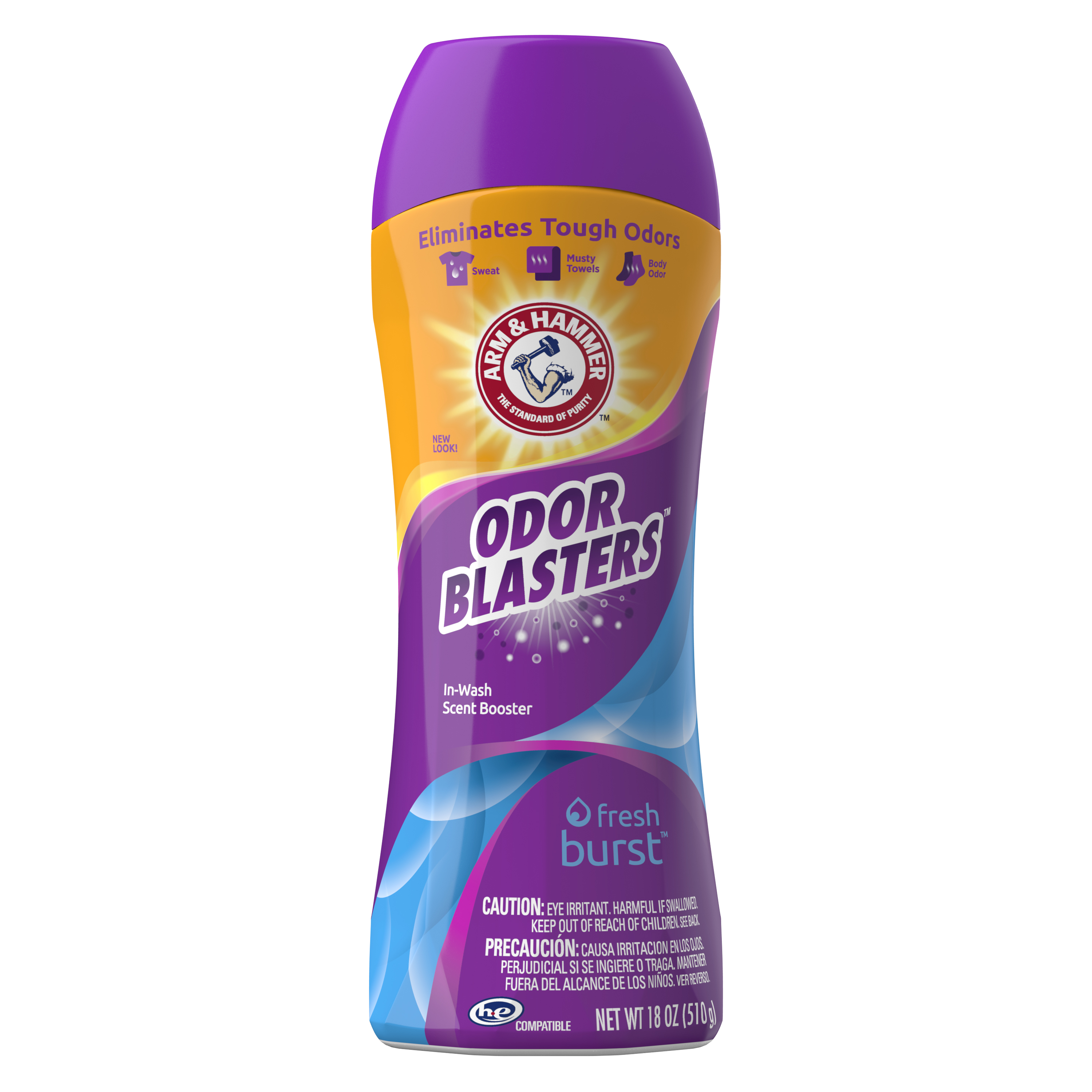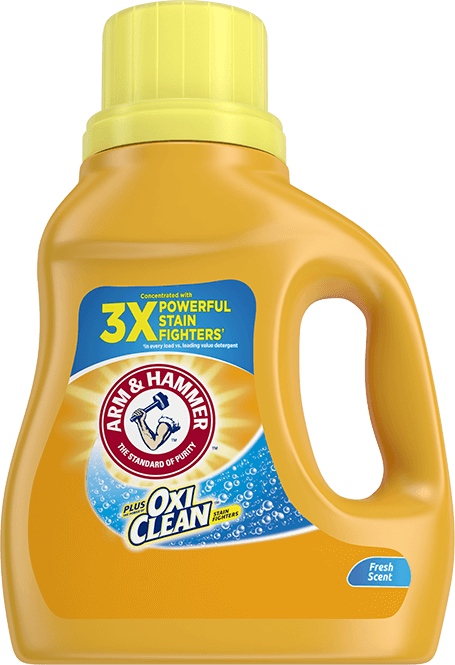How Does Laundry Detergent Clean Clothes?
Most ingredients in laundry detergent attract, break down, surround, and remove dirt and oils, or help those ingredients do their job better. Other ingredients help neutralize odors and infuse your clothes with a fresh clean scent or help whites look whiter and colors appear brighter.
What are the Key Ingredients in Laundry Detergents?
Laundry detergents typically contain ingredients like surfactants (to penetrate fabric fibers and remove dirt and oil), chelators (to surround metal ions in water), dispersion agents (to wash away dirt in the rinse cycle), stabilizers (to help ingredients work together), and fragrance. They may also have brighteners, enzymes (to target specific stains), pH adjustors and preservatives (to protect enzymes so they can function), bleach, or dyes on their ingredients lists.
Learn more about the functionality of these ingredients in our “How Does Laundry Detergent Work?” article .
What are Surfactants in Laundry Detergent?
Surfactants are molecules organized as long chains, with one end of the chain binding to dirt and oils and the other binding to water. They also help break the surface tension of water and fabrics so stains can be lifted from the fibers and rinsed away.
Surfactants can carry a net charge (anionic or cationic) or no charge at all (non-ionic), and they have hydrophilic and hydrophobic ends. The hydrophilic ends bind to water, with hydrophobic ends binding to dirt and oil. This is how your detergent “grabs” the dirt and how it stays in the rinse water instead of getting back onto your laundry!
Surfactants are found in liquid soaps, shower gels, shampoos, dish detergents, facial washes, and more. They’re critical in removing greasy stains. Some common surfactants you may see on a laundry detergent label include: sodium alkylbenzene sulfonate, sodium laureth sulfate, sodium lauryl sulfate, ammonium lauryl sulfate and potassium alcohol sulfates. There are also non-sulfate surfactants, such as cocamidopropyl betaine.
What is Cocamidopropyl Betaine in Laundry Detergent?
Cocamidopropyl Betaine is a plant-based surfactant that comes from coconut oil. It binds to dirt and oil to remove them from fabric fibers in the wash and is also a foaming agent that can be used instead of sodium lauryl sulfate (SLS) in sensitive detergents.
What are Enzymes in Laundry Detergent?
Enzymes are living biological agents that target very specific stains . They are complex proteins used in detergents to speed up reactions and break down stains so they can be washed away.
Different enzymatic detergents may contain different proteins. Protease enzymes target stains from blood, fat, chocolate, grass and more. Amylase enzymes target starch-based stains. Enzymatic detergents with Lipase will help break down fat and oil stains, while detergents with Mannanase enzymes go after food stains caused by additives like guar gum and xanthan gum, commonly found in sauces, ice cream and more.
Which ARM & HAMMER™ Detergents Contain Enzymes?
All ARM & HAMMER™ laundry detergents containing OxiClean™ stain fighters have enzymes to target specific stains such as food, blood, grass and more. The ARM & HAMMER™ Plus OxiClean™ line features liquid laundry detergents, powdered detergents, and Power Paks.
If you or members of your family are sensitive to enzymes in detergents, opt for a detergent formulated for sensitive skin , like ARM & HAMMER™ Sensitive Skin, Free & Clear .
Why Do ARM & HAMMER™ Detergents Contain Baking Soda?
Baking soda is an essential ingredient in ARM & HAMMER™ laundry detergents. It helps neutralize odors by balancing pH levels – especially those nastier ones like sweat and urine. Baking soda also softens the wash water, which helps the detergent perform better.
In fact, it’s not a bad idea to consider sprinkling a ½ cup of baking soda into your empty washer before adding your items to help get your clothes extra clean, fresh and soft!
What Chemicals are in Laundry Detergents?
Chemicals in laundry detergent simply refer to substances that have been processed, purified, refined or prepared from another substance using chemistry. Scientists can take an element’s molecular components and recombine them in new ways to make specialized ingredients by adding oxygen, carbon dioxide, hydrogen, or sulfur, for example. These new substances perform specific functions, such as isolating dirt and oil or surrounding metal ions in water.
The word “chemicals” itself should not scare you. That said, you may be curious about potentially harmful chemicals in the products you buy. Resources like SkinSAFE® help collect data and independently evaluate various products, including ARM & HAMMER™ detergents, to help you make choices about ingredients for you and your family.
Whether it’s an enzymatic detergent or one for sensitive skin , ARM & HAMMER™ detergents harness the cleaning and deodorizing power of natural baking soda and many are among the gentlest detergents for your skin – while still being tough on stains and odors.
Consult the glossary of laundry detergent ingredients below to learn more. You can also get a closer look at the ingredients in ARM & HAMMER™ laundry detergents on the ingredient disclosure page .
Alphabetical List of Common Laundry Detergent Ingredients

Of course, there are far more than just a few ingredients in laundry detergent. What do they do? We’re going to define the various ingredients and explain what their purpose is in laundry detergents.
Acrylic acid homopolymer – Also known as polyacrylic acid or Carbomer, this alkali salt is used as a dispersing agent in detergents, paint, and nail polishes. It keeps liquid combinations together (think of an emulsified oil and water mixture, such as mayonnaise or salad dressing) and allows for ingredients to be evenly concentrated throughout the liquid.
Alkyl ethoxy sulfate – A common anionic surfactant (see below) used in shampoo, liquid soap, dishwashing detergent and laundry detergent. AES helps remove dirt and oil from fabrics (or dishes or your hair and skin) and create suds.
Alkylbenzene sulfonic acid – Also sometimes listed as linear alkylbenzenesulfonate, this is one of the most widely used anionic surfactants in the world. It’s been around since 1964, and can be found in many liquid soaps, shampoos, dishwashing detergents and laundry detergents. In detergents, it surrounds dirt and oils and then bonds with water to remove them with the rinse cycle.
Anionic surfactant – These molecules have a negatively charged end that is attracted to water (hydrophilic) and repelled by the fabric. The other end of the same surfactant molecule is attracted to dirt and oil and bonds with those particles. Anionic surfactants create suds and help penetrate the fabric to remove dirt and oil.
Amylase – An enzyme that targets and breaks down starch-based stains such as from corn, potatoes, rice, and many thickeners.
Borax pentahydrate – In liquid laundry detergents, this ingredient helps to stabilize enzymes and keep them from degrading in the bottle. It also softens water to allow the surfactants to work better. In powdered detergents, it is used to adjust pH.
Calcium chloride – This ingredient is used in laundry detergents to stabilize enzymes and keep them from degrading in the bottle.
Carboxymethylcellulose* – A polymer that contains plant fibers and is sometimes used in liquid laundry detergents to help build the viscosity – or to make the liquid thicker and less runny. It also helps keep dirt that has been removed from clothes from settling back onto them.
Citric Acid – This ingredient is common in sour foods and citrus juices, but when used in laundry detergents it helps to prevent mineral buildup on your clothes and your washing machine.
Disodium distyrylbiphenyl disulfonate – An optical brightener that coats clothing fibers to make them appear more white or bright. It’s similar to the former whitening technique known as “bluing” and works by causing the fabric to reflect more blue light vs. yellow light. Your clothes come from the store coated with optical brighteners. As these wear off over time or with repeated washing, clothes appear dingy and less white. This ingredient adds the brighteners back to the clothing fibers.
Ethoxylated C12-15 alcohols – These non-ionic surfactants are a “fatty alcohol” that helps break the surface tension of water. This allows your laundry to get wet and the cleansers to penetrate the clothing fibers. Linear surfactants biodegrade quickly and are more environmentally friendly. They are widely used in laundry detergents, cosmetics, and glass or surface cleaners.
Linear alcohol ethoxylate is a common ethoxylated C12-15 alcohol you’ll find in many laundry detergents. It bonds to grease and oil deposits on your clothes to pull them out of the fibers and away in the rinse. It’s especially good for cleaning oils and sweat from our own bodies that end up on clothes and linens, as well as greasy stains from foods or makeup.
Fragrance – An optional ingredient in laundry detergent to make your clothes smell clean, fresh, and pleasant.
Hydrated silica – This compound naturally occurs in the form of the opal gem and as diatomaceous earth. About 12 percent of the earth’s crust is made of silicon dioxide, from which hydrated silica is derived. It’s commonly used in toothpastes and as a stabilizer in beer. In laundry detergents, you’ll usually find it in the individual paks to aid in breaking down the packet and helping other ingredients work.
Hydrogen peroxide – Some laundry detergents and stain pretreatment solutions contain hydrogen peroxide to help whiten and brighten clothes, disinfect them, and reduce soap buildup. It breaks down into oxygen and water, so it’s safe for the environment and your home.
Lipase** – An enzyme that targets and dissolves fat-based stains such as from butter.
Liquitint™ blue dye – A dye that makes your laundry detergent a deep, rich blue but doesn’t color your clothes.
Mannanase – An enzyme that targets food stains that contain common additive and thickeners used in foods such as guar gum and xanthan gum.
Palm kernel fatty acids – Derived from the seed of an oil palm plant, this common ingredient is used to control lather and suds in shampoos, soaps, and detergents. It also helps hold liquid detergents together and allow the surfactants to work better. In ARM & HAMMER™ laundry detergents, palm kernel fatty acids are used as a defoamer, so there aren’t too many bubbles in your machine.
Potassium chloride – This ingredient helps dissolve powder detergent in cold water.
Propylene glycol – This common food additive is also used in powdered laundry detergents as an anti-caking agent to help keep the powder loose and separate.
Protease – An enzyme that targets and breaks down protein-based stains such as chocolate, blood, and grass.
Sodium bicarbonate – Also known as baking soda, this ingredient helps neutralize odors and acid-based stains. Baking soda is refined from trona, a natural ore mined in the US. Adding carbon dioxide to sodium carbonate creates sodium bicarbonate.
Sodium carbonate – Also known as soda ash or washing soda, this ingredient acts as a chelator, pH adjuster and a booster that helps other ingredients clean your clothes more effectively. It is a naturally occurring compound mined from the earth as trona ore and refined into powdered form.
Sodium chloride – NaCl is simply table salt. It is used to help build viscosity, making your liquid laundry detergent more thick and less runny.
Sodium formate – This is an enzyme stabilizer in liquid detergents. It keeps the enzymes from degrading in the bottle so they are ready to work when they hit the water in your machine.
Sodium hydroxide – Used to adjust the pH in laundry detergents. Detergents containing enzymes need their pH lowered so that the enzymes remain stable. Other detergents have higher, or more alkaline, pHs to prevent microbial growth and to target many acid-based stains, such as tomatoes and most condiments.
Sodium laureth sulfate – A common anionic surfactant often created from coconut oil, palm kernel oil, or a synthetic source. Used in shampoos, body washes, eye liner, mascara, and many detergents, sodium laureth sulfate creates lather and foam, and binds to dirt and oils to remove them from your laundry.
Sodium percarbonate – Also sometimes listed as sodium carbonate peroxide, this ingredient is used in powdered detergents as a chlorine-free bleaching agent. It’s made by adding hydrogen peroxide to soda ash (sodium carbonate). When it comes in contact with water, it releases oxygen and hydrogen peroxide to get clothes cleaner and brighter. It breaks down into just water and oxygen, so it’s environmentally friendly.
Tetrasodium EDTA – A common chelator or chelating agent, it works to surround and trap metal ions found in hard water, such as calcium, iron, copper, and magnesium. This is important to keep them from interfering with the cleaning process.
2-methylisothiazol-3(2H)-one and 1,2-benzisothiazol-3(2H)-one – These preservatives and anti-microbial agents are used in cosmetics, lotions, moisturizers, sanitary wipes, shampoos, sunscreens, and liquid laundry detergents. They keep your laundry detergent from becoming contaminated with any bacteria or other germs.
Water – Liquid detergents contain water to hold, suspend, and carry all of the other ingredients. Powdered detergents are made to dissolve in water, allowing its ingredients to then get to work.
Zeolite – This ingredient is a natural volcanic rock added to some laundry detergents to absorb metal ions that occur in water, making it more “soft” and more effective for cleaning.
* This ingredient is not used in ARM & HAMMER™ laundry detergents or pretreating laundry products, but may be found in other brands’ formulas.
** This ingredient is found in ARM & HAMMER™ laundry pretreatment solutions but not in ARM & HAMMER™ laundry detergent.
Learn More About Laundry Detergent Ingredients and How They Work
Our ARM & HAMMER scientists work carefully to create the safest, most-effective, most affordable laundry detergents available. There are multiple formulas to suit your preferences, from powdered to liquid to individual paks and from popular fresh scents to fragrance- and dye-free.
Check out different ARM & HAMMER™ laundry detergents on SkinSAFE® and see how they contain friendly ingredients and the stain-fighting power to give your items a lift.

Some of our favorite detergents include:
- ARM & HAMMER™ Sensitive Skin, Free & Clearis free from perfumes and dyes, yet tough on stains and gentle on your skin.
- ARM & HAMMER™ plus OxiClean™ with Odor Blasters laundry paks use 5-in-1 cleaning power and attack musty odors on things like towels and workout clothes.
Looking for more options? Explore the entire line of ARM & HAMMER laundry products



